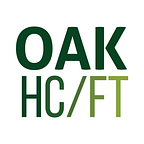By Andrew Adams, Co-Founder & Managing Partner, Oak HC/FT
In November, Paladina Health, Activate Healthcare and Healthstat went to market under one name: Everside Health. Everside Health CEO Chris Miller sat down with Oak HC/FT Co-Founder & Managing Partner Andrew Adams to discuss the evolution of Everside Health and the future of primary care.
What are Everside Health’s key focus areas after combining the Paladina Health, Activate Healthcare and Healthstat organizations?
Our first focus area was the overall integration of the three legacy brands. Each organization brought a different skill set to the table, and we worked to utilize each one of these when building Everside Health. Activate Healthcare brings expertise with unions and Taft-Hartley organizations, Healthstat brings expertise from over 200 health centers, and Paladina Health brings expertise of holding a legacy of geographic clusters and near site shared model centers. The healthcare system is deeply flawed, so with Everside Health, we’re hoping to create a complete direct primary care solution that’s customized for the clients we’re serving.
Virtual-first primary care took center stage as a result of the COVID-19 pandemic. Is that transition here to stay and what is your vision in this area for Everside Health?
Virtual-first primary care is here for the long term. Pre-pandemic, about 4% of our visits were done virtually. At the height of the pandemic, we were doing about 70% of our visits virtually. Based on that trend, we believe this is a pivot that’s here to stay, especially if you think about the clients we’re serving — market unions, municipalities, school districts and manufacturing companies — who aren’t typically early adopters of technology.
The pandemic allowed these members to embrace the concept of virtual care, and we want to continue to extend that capability for them. Right now, over 81 million Americans do not have access to primary care, and the pivot to virtual care enables Everside Health to reach those underserved populations in what are classified as medical deserts.
Evolving consumer behaviors and expectations driven by the pandemic are requiring healthcare companies to prioritize the patient experience. How is Everside Health enhancing the consumer experience?
Our mission is to provide a massively differentiated experience for the client and the patient. We think about things through the lens of the patient first. Healthcare today is driven by a fee-for-service model — doctors are incentivized on volume, not on quality. With salaried providers who are incentivized to spend time with their patients and provide a better experience, our model aims to change the entire landscape.
We combine this model with our other capabilities — such as software that provides detailed patient information on mental health and social determinants of health to our care providers — to improve the patient experience and patient outcomes.
What are some of the tailwinds today that are driving growth for Everside Health?
The movement away from fee-for-service, the education around value-based care, and the results we’re providing — for both clients and patients — are driving massive growth for Everside Health.
Everside Health typically saves clients 10% to 40% on year-to-year healthcare spend. For patients, we provide 24/7 access, same day and next day appointments, and longer appointments. Patients with chronic conditions that require extra care can meet with physicians as often as once a week for appointments up to 90 minutes because we have much smaller panel sizes for physicians than providers that use the traditional fee-for-service model. In the fee-for-service world, physicians are serving a panel size of up to 2,500 patients, while our panel sizes are generally 600 to 1,000 patients.
What are the biggest challenges in primary care? How are you tackling those challenges at Everside Health?
The primary care system is largely broken and deeply flawed. The United States spends 2 times more on healthcare than the average OECD country, and 17% of our GDP is spent on healthcare. Yet the United States has a 2-year lower life expectancy and 60% higher chronic disease burden than the average OECD country. Americans lack access to primary care, and 44% of Americans don’t go to the doctor because of the cost that’s associated with the visit.
Our model fundamentally changes that, and we continue to provide improved clinical results for patients and cost savings for clients. Our statistics show that our model works with our Net Promoter Score of above 84.
What’s next for Everside Health?
We’re growing fast to meet demand. This year, we’re planning to open or expand 50 new health centers. We’re also expecting to continue to establish new partnerships and invest in technology to create a differentiated experience for both patients and providers. A key focus for us is the ancillary services beyond primary care, such as mental health and even dental. Our goal is to provide a complete care solution for our clients.
Lightning Round
· If I weren’t working at Everside Health, I would be… running a mental health company, which is what I was doing prior to Everside. It’s a service that’s near and dear to my heart. More people need better mental health care.
· What’s on your desk right now? Pictures of my family, a to do list, and my COVID-19 vaccination card.
· What one piece of advice would you offer to an entrepreneur? The key to accelerating success for any entrepreneur is having a great mentor.
